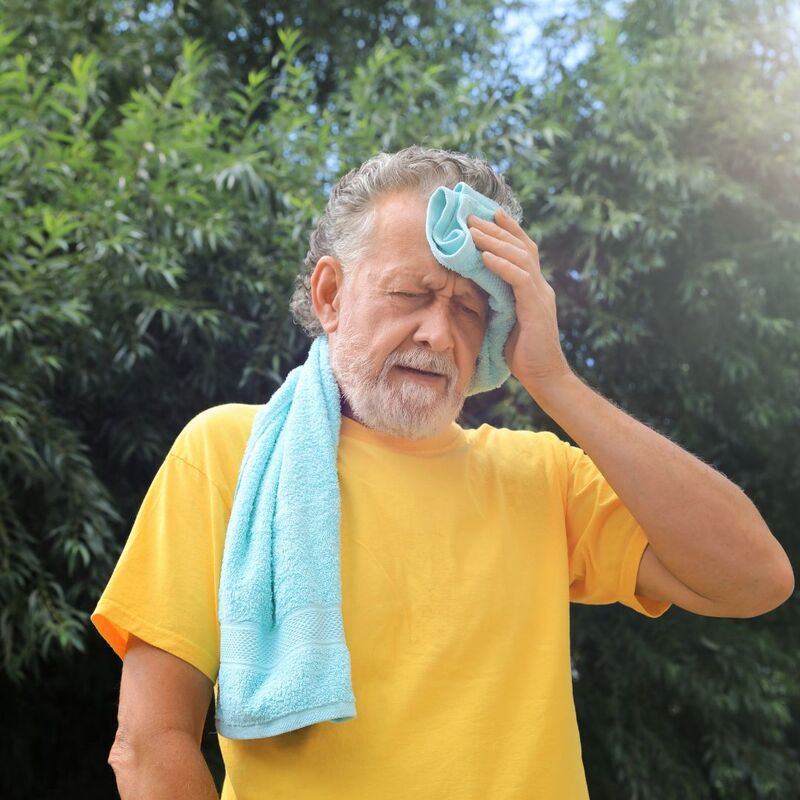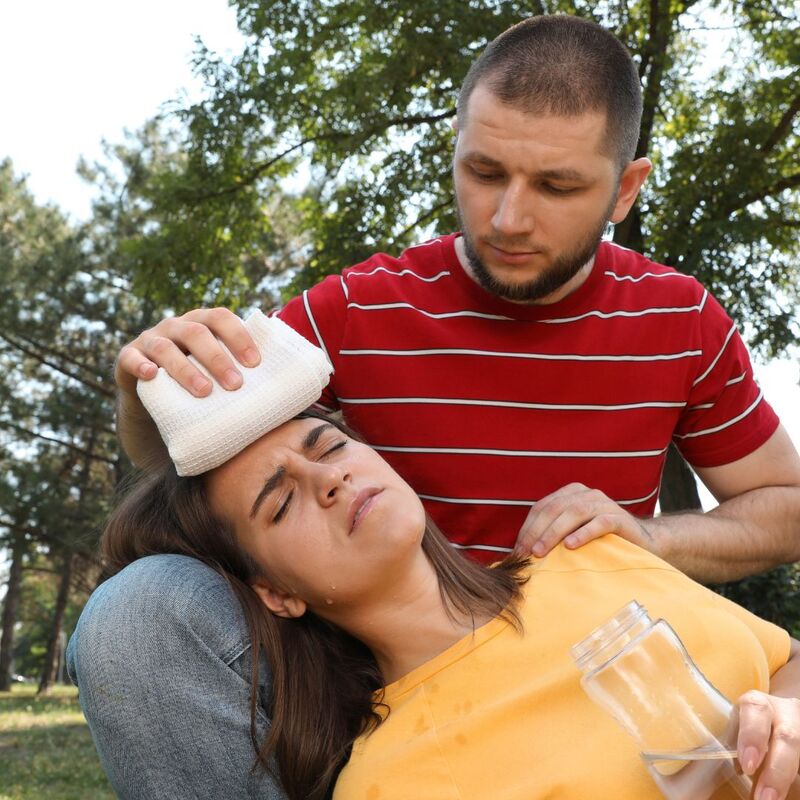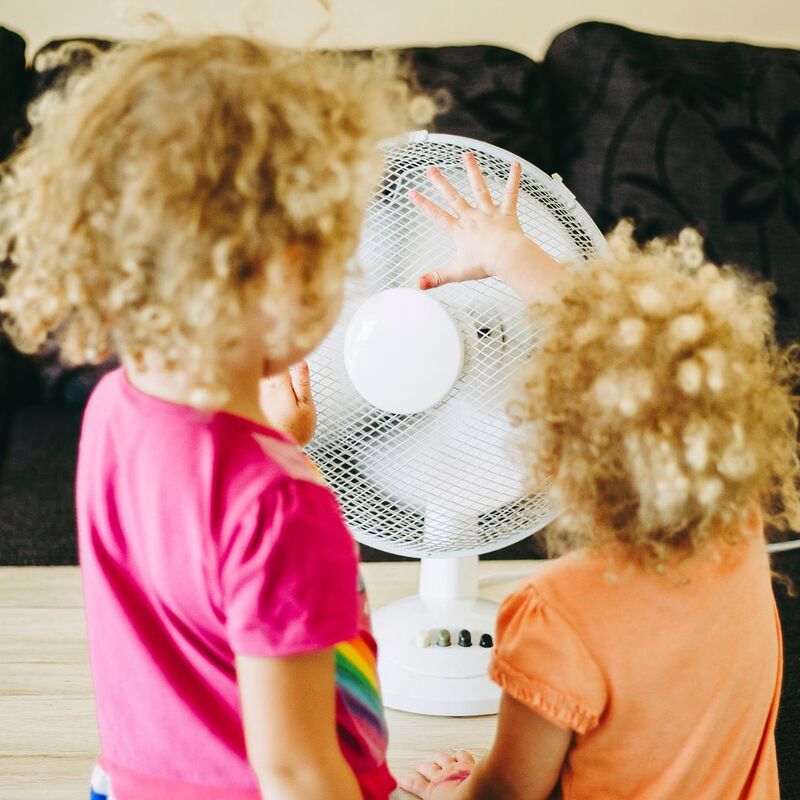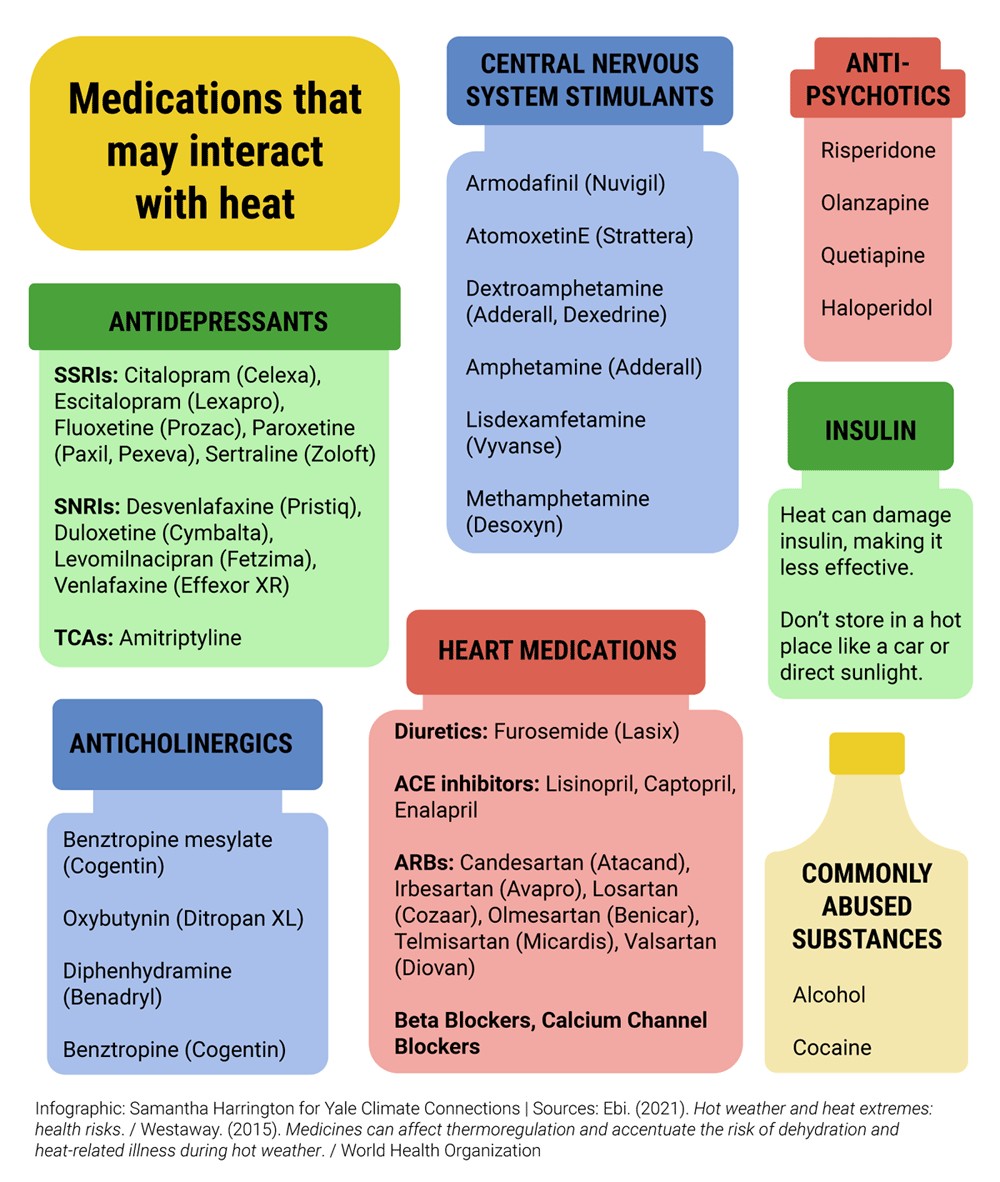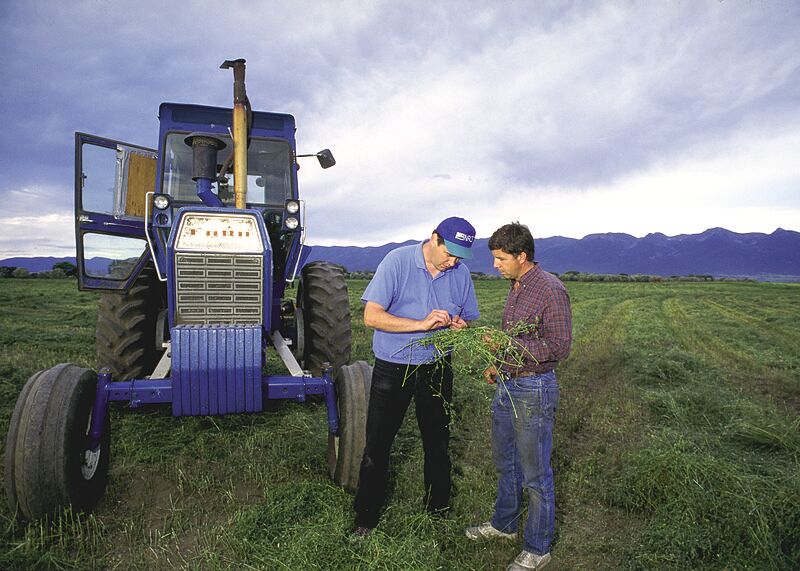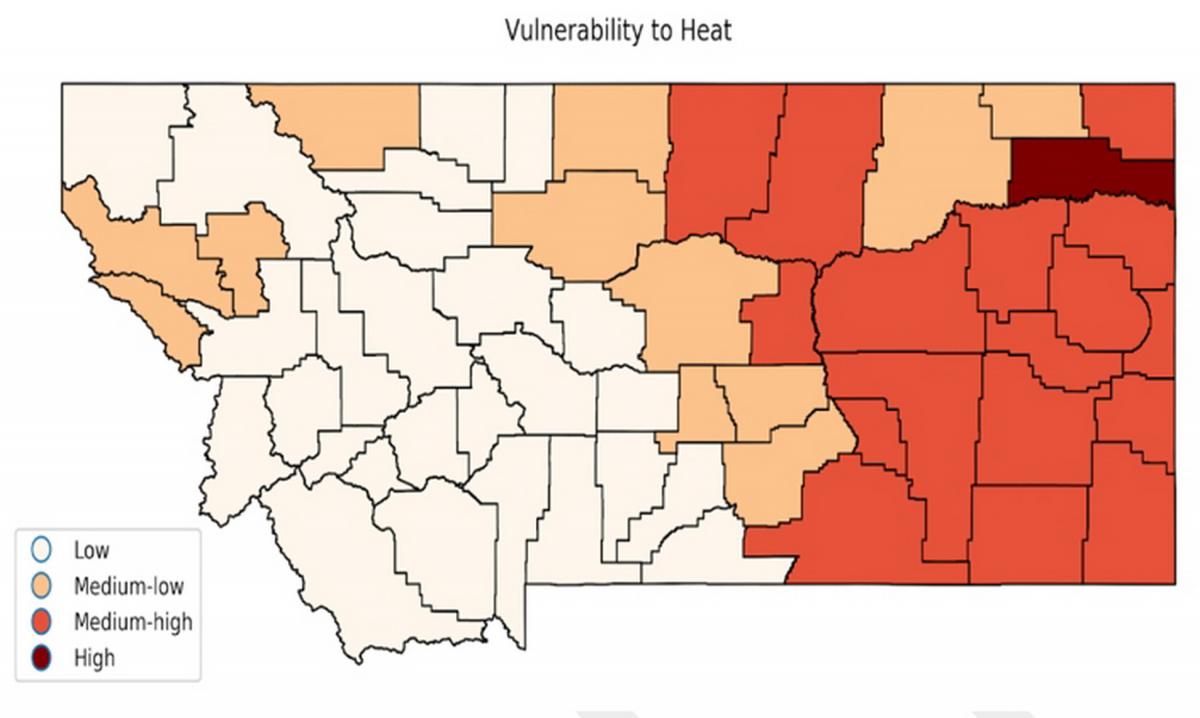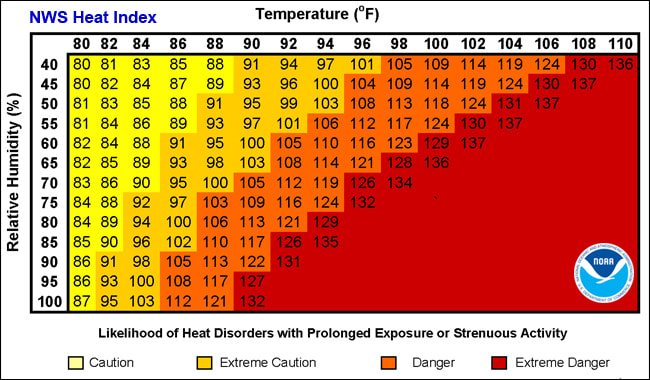Patients
Extreme Heat Can Be Deadly. Stay Safe.
In the US, heatwaves kill more people than any other extreme weather, including hurricanes, tornadoes, and floods (source). Extreme heat is becoming more common -- in eastern Montana in particular, by 2050 we are expected to have around three more weeks above 90°F every year (source).
What Heat Can Do
|
Getting hot enough can cause:
|
Heat exhaustion or heat stroke?
Being in extreme heat too long can give you a headache, make you feel dizzy and nauseous, and even make you pass out. Two different conditions can do this, and the treatment is different for each. Hover over the pictures to tell the difference between heat exhaustion and heat stroke.
|
First Aid
- Heat stroke: Call 911. Get the person to a cooler place if possible. Use cool cloths or a cool bath to cool the person down. Do not give them anything to drink.
- Heat exhaustion: Get to a cooler place. Use cool cloths or a cool bath to lower temperature. Slowly sip water, or something with electrolytes like Pedialyte or Gatorade. Get medical help right away if the person vomits, or if they are sick for more than an hour.
DehydrationDrinking enough water is especially important for your health during hot weather. Not drinking enough water can mess up your whole system, from your kidneys to your brain. Drinking water also helps keep you cool. Whether you work at a desk or out in the heat, you need to drink water.
|
Who is at risk?
Everyone can be affected by extreme heat. Some people, including pregnant people, children, and the elderly are more at risk. Certain medications also make you more sensitive to heat.
Agriculture & Heat
|
Heat causing health problems is bad enough -- but it causes other problems for Montanans too. We are a proud farming and ranching state, and heat can throw those industries off course. For a detailed analysis of the coming issues for agriculture and rangeland, you can read "The Impact of Climate Change on Montana's Agriculture Economy" from the Montana Farmer's Union. Here are some key points:
|
Plan ahead.
You aren't powerless when it comes to rising temperatures. Here are some things you can do:
- Keep your house cooler than 80°F. Open your windows at night and close and cover them during the day. During smoke season you can place a fan with a HEPA filter in your window at night and block off the rest of the window to avoid breathing smoke, which is bad for you.
- Advocate for heat safety at work. OSHA has a good guide.
- Learn the signs of heat stroke, heat exhaustion, and other heat-related illnesses. Keep an eye on the temperature when you are outside, and avoid being out during the hottest part of the day if you can.
- Find out if any of your medications can make you more temperature-sensitive. Also, store your medications in a cool place -- meds for thyroid, diabetes, and pain are some common meds that break down in heat.
- Make sure your county or city includes heat waves in their safety plan. If they don't, ask them to!
- Help create cool and friendly public spaces for people without air conditioning in your town, including unhoused folks. Everyone deserves to have shelter from the heat.
- Call your legislators to encourage them to vote for climate-friendly policies.
Providers
Heat kills more people in the US than any other weather - even more than hurricanes, tornadoes, and floods.
-NWS, 2022.
-NWS, 2022.
Heat in Montana
We know a good deal about Montana's specific heat issues. There is a strong West-to-East trend in heat vulnerability. However, the entire state is already seeing more days above 90°F, and will likely see even more in the future (MT Climate Assessment, 2017). These days of extreme heat are dangerous.
Khatana et al, 2022 found that each additional day of extreme heat (at or above 90 °F) in a month was associated with 0.07 additional deaths per 100,000 adults. In a state the size of Montana, this is about five to eight deaths for every day above 90 °F. |
Tell your patients:
- Drink water.
- Give your body a few days to get used to the heat before doing heavy activity.
- Do not do heavy activity when it's hotter than 90°F.
Patients should try to keep the temperature of their home below 80°F. A good tip is to open windows at night and close and cover them during the day. During periods of wildfire smoke, a fan with a HEPA filter can be placed in a window, with the rest of the window blocked off.
Heat affects every system in the body.
Go to section:
Neurological
Cardiovascular
Respiratory
Gastrointestinal
Nephrological
Frontline Communities
Neurological
Cardiovascular
Respiratory
Gastrointestinal
Nephrological
Frontline Communities
Neurological Effects
Dementia
People with dementia have higher rates of emergency admissions at high temperatures. In addition to the reduced thermoregulation common in older adults, people with dementia have reduced awareness and language that may make noticing and coping with dehydration and heat harder. Some antipsychotic medications also decrease thermoregulation. Remind caregivers to be diligent about hydration and aware of the effects of medications. (Gong et al 2022). |
|
Multiple Sclerosis
MS patients experience a transient worsening of physical and cognitive symptoms when temperatures rise. High temperatures decrease axon safety factor for saltatory conduction, ultimately leading to conduction block. Areas of the brain responsible for thermoregulation can degrade in MS. Cooling and pre-cooling strategies may help prevent harm. (Davis et al 2010) |
Mental Health
People with mental health conditions face higher morbidity and mortality than people without these conditions during days of extreme heat. In one study, "deaths due to schizophrenia and schizotypal and delusional disorders increased more than 2-fold during heat-wave periods" (Hansen at al, 2008). Psychotropic and antipsychotic medications affect thermoregulation, higher poverty rates exacerbate heat exposure, and maladaptive coping strategies may also play a role. Of particular note is the correlation between suicide and extreme heat. (Thompson et al, 2018; Meadows et al 2024). |
Cardiovascular Effects
Heart Rate
Heat increases heart rate, and an increase in heart rate increases the body's oxygen demand, including in heart muscle. If cardiac muscle is already impaired, this can tip things over the edge into infarction. Caution patients with heart conditions to stay out of extreme heat, and caution all patients to avoid exercising in extreme heat. Support labor protections to keep outdoor laborers from being forced to work in extreme heat. (Liu et al, 2015) Dehydration Drinking enough water in high temperatures is often overlooked, and combined with increased sweating dehydration often occurs. Dehydration increases the risk of plaque rupture events such as stroke and heart attacks. |
Respiratory Effects
Asthma
Heat increases bronchoconstriction in asthmatic patients, which may impair lung function. (Hayes et al, 2012). Of note, asthmatic pregnant people are more susceptible to preterm birth and stillbirth during extreme heat. (Bekkar et al, 2020) All Lung Diseases Heat promotes ground-level ozone, which is of extra concern to those with lung disease. Inflammation caused by ozone has been described as "like a sunburn in your lungs." AirNow.gov provides up to date local ozone data, which patients with lung diseases can use to mitigate risk. (EPA) |
Gastrointestinal Effects
Heat Stroke Starts in the Gut
Vasodilation is part of the body's strategy to stay cool. During heat stroke, blood is brought to the extremities to cool down. Meanwhile, gut blood flow decreases as blood (and therefore oxygen) pushes to the extremities. If the gut goes without enough oxygen for too long, toxins build up and leak into the blood, causing systemic inflammatory response syndrome (SIRS) and eventually multi-organ failure. (Liu et al, 2015) |
Nephrological Effects
Heat Stroke & Kidney Disorders
Patients with chronic kidney disease are more at risk for heat stroke (Sasai et al, 2023). Heat exhaustion or heat stroke in any patient can cause acute kidney injury (AKI) and renal failure due to dehydration and rhabdomyolysis. During heat waves, expect hospital admissions for AKI to rise (Lorenzo y Liaño, 2017). Outdoor workers, people of color, and the elderly are especially at risk. Hot Weather and Kidney Disorders Even outside of heat waves, hotter weather is associated with higher rates of acute renal failure, urinary tract infections, renal calculi, lower urinary calculi, and other lower urinary tract disorders (Fletcher et al, 2012). Encourage patients to hydrate and stay out of the heat as much as possible. It is possible allopurinol may have a protective effect on renal function in people who experience recurrent heat stress, but human trials have not been done (Roncal-Jimenez et al, 2018). |
Frontline Communities
Pregnant People and Infants
Preterm birth, low birth weights, and other adverse health outcomes are associated with extreme heat (Bekkar et al, 2020 , Wheeler et al, 2022). Pre-eclampsia, gestational diabetes, and emergency room admission are also related; a variety of hypotheses for the mechanisms of these complications are discussed in Samuels et al, 2022. Pregnant patients should be especially encouraged to avoid extreme heat (85°F or higher).
|
Outdoor WorkersOutdoor workers have less protection from extreme heat by the nature of their jobs. From 2011 - 2021, at least 436 people lost their lives to environmental heat exposure at work (Bureau of Labor Statistics, 2023). Some experts think this number could be much higher, because coroners often mis-attribute heat-related deaths to the cardiac failure that can happen as a result of heat stroke. In addition to death, heat stroke can cause injuries to internal organs which can take years to heal.
OSHA has resources for workers and employers to prevent heat illness. Note that chemicals can change toxicity in extreme heat, especially pesticides and ozone, and ask patients to use extra precautions when handling these substances (Applebaum et al, 2016). Advocate for labor protections that require breaks for hydration, mandatory work stops during extreme heat, and effective penalties for employers to discourage noncompliance. |
|
Native People and People of Color
Latino workers accounted for a third of work-related heat stroke deaths, despite being 17% of the workforce (NPR, 2021). As of 2023, OSHA does not have a specific heat standard for workplace illness prevention, but intends to make one.
Climate change and sources of climate pollution "significantly and disproportionately" degrade tribal lands, leading to health impacts and disruptions in traditional practices (Agumanu McOliver et al, 2015). Tribal nations have always been leaders in environmental stewardship, and most have strategic plans to take on climate change and its' health impacts. Some examples include the Blackfeet, Salish & Kootenai, and Northern Cheyenne nations. Their leadership is crucial for the health of all Montanans. |
Administrators
Heat is the most deadly weather in the USA; deadlier than hurricanes, tornadoes, and floods.
-NWS, 2022.
-NWS, 2022.
In June of 2021, it got above 107°F in Seattle for three days. There were an average of 22 additional ED visits per day during that time, with visits lasting an hour longer than usual (Wettstein et al, 2024). This and other studies show that you can expect extra burden on capacity during extreme heat (usually counted as 90°F or hotter for more than one day) (Kegel et al, 2021). Montana is is already seeing more days above 90°F, and will likely see even more in the future (MT Climate Assessment, 2017). So, plan for it!
Effective Heat Risk Programs
Assessing Heat Risk
|
Factors that influence heat risk:
But how do I quantify that?
|
The Heat Index takes temperature and humidity (in windy, shady conditions) and calculates risk of heat disorders.
The Wet Bulb Globe Temperature (WBGT) predicts heat stress risk for active working people in full sun. It takes into account more factors than just temperature, making it very accurate for risk assessment during direct sun exposure.
The Wet Bulb Globe Temperature (WBGT) predicts heat stress risk for active working people in full sun. It takes into account more factors than just temperature, making it very accurate for risk assessment during direct sun exposure.
There's an app for that!
|
For ED Managers: CDC Heat & Health Tracker
The CDC's Heat & Health Tracker shows trends in local ED admissions for heat-related illness. ED Managers can use this to plan ahead, keeping emergency departments from being overburdened. |
For Patients: OSHA-NIOSH Heat Safety Tool App
This app shows the local Heat Index and Wet Bulb risk levels. It is useful for anyone working or recreating during high temperatures, and can recommend appropriate breaks as well as symptoms and first aid info. |
DO THIS BEFORE THE NEXT HEAT WAVE: Extreme Heat Alert Plan
Americares has a simple, two-page planning tool for:
- how heat alerts get communicated in your clinic
- how your clinic is optimized for hot days
- how patients are protected from heat in the clinic
- how providers are supported during a heat wave
From all of us at MTHPHC, thank you for thinking ahead to protect your patients and providers!

